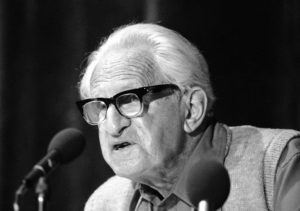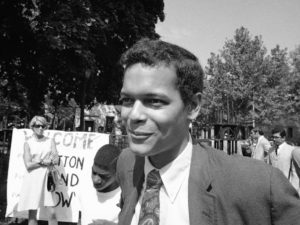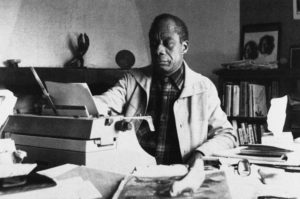Bin Laden of the Indian Wars
Author Robert M. Utley's account of the elusive Geronimo is a fascinating but sometimes frustrating story.
“Geronimo” A book by Robert M. Utley
Geronimo famously eluded the United States Army during his lifetime, and he has been dodging historians since his death. Robert M. Utley, a distinguished chronicler of the West and author of a biography of Sitting Bull, is the latest to make the chase, and he has succeeded as well as anyone will. The biographer’s tools are largely missing for a figure like Geronimo. Few outside his circle of Chiricahua Apaches ever heard of him until he reached middle age; consequently no one recorded impressions of him or noted his comings and goings. There are no news reports from this period, no diaries or letters. Utley relies in part on Geronimo’s dictated and translated memoir, even while acknowledging the limitations imposed on the account by advanced age (Geronimo was 83 when he told his story) and disparities in culture. He supplements it with what his long study of Indians and the West has taught him, explaining the circumstances under which Geronimo grew up and from which he emerged as a war leader (though not a chief, as Utley points out).
The result is a fascinating but sometimes frustrating story. We learn a great deal about life among the Apaches in the Southwest in the 19th century. But about Geronimo himself we read mostly conjecture. “What part Geronimo played in Cochise’s battles with the California Volunteers for the three years after the death of Mangas Coloradas in 1863 can only be speculated,” Utley writes in one place. “He must have fought with distinction at Horseshoe Canyon,” he surmises elsewhere. “His ferocity as a fighter undoubtedly placed him in the forefront of the fights at Cedar Springs and the Dragoon Mountains,” he concludes of two other battles.
The story grows more specific as Geronimo becomes the bete noire of U.S. Army forces in Arizona and New Mexico. Many Apaches, like many of the members of other tribes, resigned themselves to existence on the reservations set aside for them by the federal government. Others resisted. Crazy Horse and Sitting Bull led the Sioux resistance on the Northern Plains; Quanah Parker headed the Comanche resistance on the Southern Plains. And Geronimo became the symbol of Apache resistance in the Southwest. He challenged the best generals the army sent after him, outmaneuvering them on lengthy campaigns in the mountains and desert. His name appeared in army dispatches and then in newspapers; as the other Indian leaders gave up the struggle and guided their bands onto the reservations, Geronimo grew famous as the last of the holdouts.
Utley acknowledges Geronimo’s courage, determination and intelligence. But he takes vigorous issue with the romanticized image of Geronimo as a heroic defender of his homeland, popularized by a genre that includes such titles as “Bury My Heart at Wounded Knee” and “Custer Died for Your Sins.” “While Geronimo’s legacy in history is undying,” Utley says, “he emerges essentially as a not very likable man.” The perception of Geronimo as fighting for his homeland is “demonstrably untrue,” Utley asserts. Geronimo’s principal campaigns took place in Mexico, which was not his homeland but which he invaded for the purpose of raiding and plundering. Mexico brought out the worst in him, although he acted badly in the United States, too. “In both Mexico and the United States, he lived up to his reputation as a ruthless butcher,” Utley says. “Especially in Mexico, he shot, slashed, tortured, and murdered almost anyone he came across.” He lied when it served his purposes, which were not the purposes of the Apaches or even his Chiricahua band. Utley compares Geronimo unfavorably with Sitting Bull. “Unlike Sitting Bull, he often behaved selfishly, impulsively, deviously, mercilessly, egotistically, and at variance with the dictates of his culture. With Sitting Bull, his people came first. With Geronimo, he came first.”
|
To see long excerpts from “Geronimo” at Google Books, click here. |
But if not an exemplar of aboriginal nobility, Geronimo was a worthy foe of the U.S. Army. Utley recounts with verve Geronimo’s remarkable ability to evade the forces of Gens. George Crook and Nelson Miles as they tried to run him to ground. He was badly outnumbered but knew the terrain and exhibited a knack for vanishing almost into thin air. It was this ability, rather than prowess in pitched battle, that gave rise to the Geronimo legend.
Yet finally he surrendered. Pursued by the armies of both the United States and Mexico, and growing old, Geronimo came out of the mountains and gave himself up. He and his surviving followers — a mere few dozen — were sent to Florida and then Alabama, as he was deemed too dangerous to be left in the Southwest. He spent his last decade and a half in Oklahoma at Fort Sill, where he seemed content to work his garden. “Every now and then he’d take a watermelon, cut it up under his arbor, and say, ‘Come on boys,’ ” a sympathetic observer recalled. “He liked watermelon pretty well himself.” He still considered himself a warrior, though he wore the uniform of his old foe. When a spurious report of restiveness among his followers caused the commander at Fort Sill to summon him for questioning, he objected: “I am a U.S. soldier. I wear the uniform, and it makes my heart sore to be thus suspected.”
Utley tells Geronimo’s story objectively and well. But he predicts, no doubt accurately, that the myth won’t die. “The legendary Geronimo promises to live on in the American mind,” he writes, “because it gives comfort to a public, both white and Indian, that for almost half a century has been full of remorse over the fate of the victims of American expansion.”
H.W. Brands’ latest book is “The Man Who Saved the Union: Ulysses Grant in War and Peace.”
©2012, Washington Post Book World Service/Washington Post Writers Group
Your support matters…Independent journalism is under threat and overshadowed by heavily funded mainstream media.
You can help level the playing field. Become a member.
Your tax-deductible contribution keeps us digging beneath the headlines to give you thought-provoking, investigative reporting and analysis that unearths what's really happening- without compromise.
Give today to support our courageous, independent journalists.







You need to be a supporter to comment.
There are currently no responses to this article.
Be the first to respond.